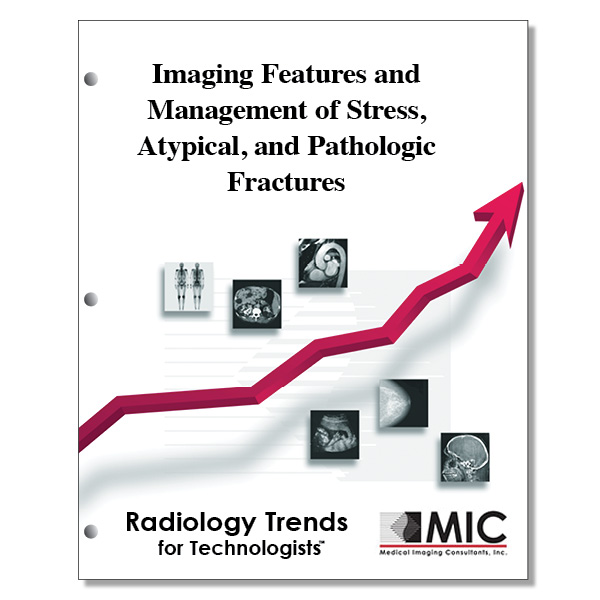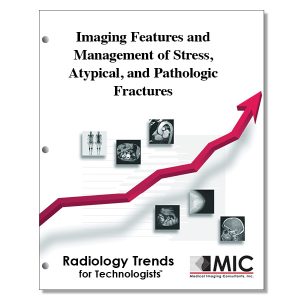

Imaging Features and Management of Stress, Atypical, and Pathologic Fractures
A review of terminology, etiology, and key imaging features that affect management of atraumatic fractures including stress fractures, atypical femoral fractures, and pathologic fractures.
Course ID: Q00599 Category: Radiology Trends for Technologists Modalities: MRI, Nuclear Medicine, Radiography3.0 |
Satisfaction Guarantee |
$34.00
- Targeted CE
- Outline
- Objectives
Targeted CE per ARRT’s Discipline, Category, and Subcategory classification for enrollments starting after January 27, 2023:
[Note: Discipline-specific Targeted CE credits may be less than the total Category A credits approved for this course.]
Bone Densitometry: 1.50
Procedures: 1.50
DXA Scanning: 1.50
Computed Tomography: 2.50
Procedures: 2.50
Head, Spine, and Musculoskeletal: 2.50
Magnetic Resonance Imaging: 2.50
Procedures: 2.50
Musculoskeletal: 2.50
Nuclear Medicine Technology: 2.50
Procedures: 2.50
Other Imaging Procedures: 2.50
Radiography: 2.50
Procedures: 2.50
Extremity Procedures: 2.50
Registered Radiologist Assistant: 2.50
Procedures: 2.50
Musculoskeletal and Endocrine Sections: 2.50
Outline
- Introduction
- Definitions and Terminology
- Bone Structure and Pathophysiology
- Stress (Fatigue) Fractures
- Imaging Findings
- Role of Imaging in Managing Stress Fractures
- Atypical Femoral Fractures
- Imaging Features
- Treatment
- Pathologic Fractures
- Imaging Findings
- Additional Treatment Considerations
- Stress (Fatigue) Fractures
- Conclusion
Objectives
Upon completion of this course, students will:
- define atraumatic/minimally traumatic fractures
- list the confusing aspects surrounding atraumatic fractures
- outline what can happen when an atraumatic fracture diagnosis is delayed
- list the factors that affect optimal management of atraumatic fractures
- subdivide the term stress fracture into two similar terms
- state how fatigue fractures commonly occur
- recall the patient population most affected by fragility fracture
- define the female athlete triad
- state where atypical femoral fractures occur in the femoral diaphysis
- list the basic principles for review when attempting to understand diverse types of atraumatic fractures
- state the strongest and stiffest material in the body
- describe the structure of trabecular bone
- describe the factors affecting the relative proportions of cortical and trabecular bone
- describe the location of cortical bone
- describe the location of trabecular bone
- list the mechanical forces to which bone is exposed
- recall how long complete bone remodeling can take
- list the steps in the bone remodeling pathway
- differentiate between stress, atypical femoral, and pathologic fracture remodeling
- recall the patient population most commonly affected by stress fracture
- differentiate between intrinsic and extrinsic factors affecting the etiology of stress fractures
- list in descending order of frequency the locations where stress fractures most commonly manifest in the lower extremity
- state the sensitivity for both early and late-stage injuries when utilizing radiography
- state the modality that is presently not considered to be a first or second-line imaging option for the diagnostic evaluation of suspected stress injury
- describe the possible manifestations of fractures that arise under tensile stress or in areas of poor vascularity
- list the treatment requirements for high-risk fractures
- recall the fatigue fracture line percentage that marks fractures as high-risk
- state the imaging modality utilized in the classification system proposed by Fredericson et al
- explain the grading system for medial tibial stress syndrome as seen at MR imaging per the Fredericson et al classification system
- interpret Table 1 in the article in order to identify atypical femoral fractures
- recall what type of fractures are more likely to relate to comminution
- list the radiographic views recommended when an atypical femoral fracture is identified
- state the percentage of patients that demonstrate a fracture in the contralateral femur either at the time of atypical femoral fracture or in subsequent years
- list the clinical factors that may increase the risk of atypical femoral fracture
- recall the patient population most likely to experience pathologic fractures
- list where pathologic fractures most commonly occur
- state the best suited imaging modality for discrimination between benign and malignant fractures
- explain the most important marrow signal intensity related to MRI in the differentiation between benign and pathologic fracture
- list features that may suggest pathologic vertebral compression fractures
- recognize features of pathologic fractures demonstrated on multiple imaging modalities
